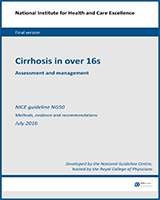|
Population
| Adult patients with cirrhosis and ascites (Child-Pugh B and C) who are at high risk of developing SBP.
Including:
Excluding:
Patients who have active GI bleeding. Patients on antibiotic therapy at the time of presentation. Patients with other confounding pathologies, for example colitis, perforation.
|
|
Interventions
| Prophylactic oral antibiotic therapy to prevent a primary episode of SBP, specifying the antibiotic, dose, frequency and duration of therapy in different subgroups. |
|
Comparison
| A placebo given for the same duration as the active treatment group or until the first episode of SBP occurs.
An alternative suitable antibiotic as a head-to-head comparator.
A crossover or sequential study could be considered. |
|
Outcomes
|
Frequency of antibiotic-related adverse effects, for example, Clostridium difficile diarrhoea, superinfection with other resistant organisms. Time to and the frequency of detection of resistant microbes in stool samples. Time to first episode of SBP or hospitalisation due to breakthrough infection. Quality of life All-cause mortality.
|
|
Importance to patients or the population
| Patients with cirrhosis and ascites have a poor quality of life and a high risk of developing SBP requiring hospitalisation and IV antibiotics.
Optimising prophylactic antibiotic therapy would improve quality of life whilst reducing the associated morbidity, mortality and healthcare costs. Judicious use of appropriate antibiotic regimes should minimise the occurrence of resistance and the ensuing adverse outcomes for individual patients, the population at large and healthcare providers. |
|
Relevance to NICE guidance
| This information will allow NICE to make a definitive statement about the overall safety and effectiveness of specific prophylactic antibiotic regimens used to prevent primary episodes of SBP.
The results may be used to ensure compliance with NICE recommendations on antimicrobial stewardship. |
|
Relevance to the NHS
| Ensures optimal use of healthcare resources. |
|
National priorities
| Public Health England Expert advisory committee on Antimicrobial Resistance and Healthcare Associated infection: Antimicrobial Prescribing and Stewardship Competencies (2013) |
|
Current evidence base
| Limited (as reviewed for the NICE Cirrhosis guideline) |
|
Equality
| Patients need to be informed about the balance of risks of prophylactic antibiotic therapy versus the likelihood and consequences of developing SBP |
|
Study design
| RCT study or sequential (crossover) study (n≥100) |
|
Feasibility
| The study population should be hepatology clinic, out-patient attenders from various centres in England who would be considered suitable for antibiotic prophylaxis. |
|
Other comments
| Funding for the study (studies) may be limited for generic antibiotics, long established in use. |
